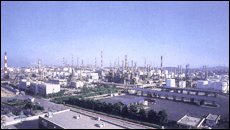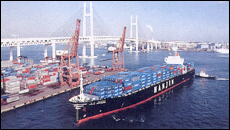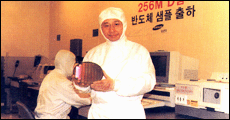![]()
1. Economic Growth Korea recently pulled through an economic storm that began in late-1997.
This crisis, which roiled markets all across Asia, had threatened Korea's
remarkable economic achievements. However, thanks to the faithful
implementation of an IMF agreement, the Kim Dae-jung government's strong
resolve for reform, and successful negotiation of foreign debt restructuring
with creditor banks, the nation is currently on track to resume economic
growth. Since the onset of the crisis, Korea has been rapidly integrating
itself into the world economy. The goal of the nation is to overcome
problems rooted in the past by creating an economic structure suitable for
an advanced economy.
Korea recently pulled through an economic storm that began in late-1997.
This crisis, which roiled markets all across Asia, had threatened Korea's
remarkable economic achievements. However, thanks to the faithful
implementation of an IMF agreement, the Kim Dae-jung government's strong
resolve for reform, and successful negotiation of foreign debt restructuring
with creditor banks, the nation is currently on track to resume economic
growth. Since the onset of the crisis, Korea has been rapidly integrating
itself into the world economy. The goal of the nation is to overcome
problems rooted in the past by creating an economic structure suitable for
an advanced economy. Korea, once known to be one of the world's poorest agrarian societies, has undertaken economic development in earnest since 1962. In less than four decades, it achieved what has become known as the "economic miracle on the Han-gang river", a reference to the river that runs through Seoul-an incredible process that dramatically transformed the Korean economy while marking a turning point in Korea's history. An outward-oriented economic development strategy, which used exports as the engine of growth, contributed greatly to the radical economic transformation of Korea. Based on such a strategy, many successful development programs were implemented. As a result, from 1962 to 1997, Korea's Gross National Income (GNI) increased from US$2.3 billion to US$474 billion, with its per capita GNI soaring from US$87 to about ~S$10,307. These impressive figures clearly indicate the magnitude of success that these economic programs have brought about. However GNI and per capita GNI drastically dropped to US$317 billion and US$6,823 in 1998 due to the fluctuation in foreign currency reserves. Korean imports have steadily increased thanks to the nation's liberalization policy and increasing per capita income levels. As one of the largest import markets in the world, the volume of Korea's imports exceeded those of China in 1995, and were comparable to the imports of Malaysia, Indonesia, and the Philippines combined. Major import items included industrial raw materials such as crude oil and natural minerals, general consumer products, foodstuff and goods such as machinery, electronic equipment and transportation equipment. Korea developed rapidly from the 1960s, fueled by high savings and investment rates, and a strong emphasis on education. The nation became the 29th member country of the Organization for Economic Cooperation and Development (OECD) on December 12, 1996. With a history as one of the fastest growing economies in the world, Korea is working to become the focal point of a powerful Asian economic bloc during the 21st century. The Northeast Asian region commands a superior pool of essential resources that are the necessary ingredients for economic development. These include a population of 1.5 billion people, abundant natural resources, and large-scale consumer markets. |
2. Industrial Development The Korean government is taking major initiatives to improve the nation's
economic competitiveness by adopting a more realistic single exchange rate,
making available short-term export financing, simplifying customs
procedures, and encouraging foreign investment.
The Korean government is taking major initiatives to improve the nation's
economic competitiveness by adopting a more realistic single exchange rate,
making available short-term export financing, simplifying customs
procedures, and encouraging foreign investment. Korea's First Five-Year Economic Development Plan (1962-1966) focused on laying a foundation for industrialization. The plan successfully initiated, and then accelerated, a structural adjustment of the nation's industrial structure from subsistence agriculture to modern manufacturing and export trade. In the process of its economic growth, Korea has carried out comprehensive industrialization. The share of primary industries in the overall industrial structure decreased steadily from 26.6 percent in 1970, to 14.7 percent in 1980, and further to 4.9 percent in 1998. On the other hand, the share of manufacturing industries increased from 21.5 percent in 1970, to 30.7 percent in 1998. The share of the service industries stood at 51.6 percent in 1998, by far the leading growth sector in the economy. Korea's economic growth was initially led by labor-intensive light industries - especially textiles. The light industries were steadily replaced by the heavy and chemical industries that have come to account for over half of the nation's total manufacturing output. For instance, with the completion of the third Kwangyang blast furnace in December 1990, Korea became the 6th-largest steel producer in the world. Korea also produces a wide range of industrial machinery and equipment. The nation's shipbuilding and auto manufacturing industries have reached their peak, while its electronics industry is the leading major growth sector and an increasingly important generator of foreign exchange in 1997. As of 1997, Korea was ranked the fifth-largest auto manufacturer in the world, with a production of 2.81 million vehicles annually. To meet ever-increasing fuel demand, two large petrochemical complexes, supported by several large refineries, have been developed along the three coasts of the country. Other principal industrial products include cement, processed foods, plywood, chemical fertilizers, footwear, clothing, ceramics, glass, nonferrous metals, and farm implements. In line with the advancement of the nation's industrial structure over recent years, Korea has continued to increase its investment in the manufacturing sector. In particular, government and corporate investment in information and communications technology has been increasing. Construction-related investment has been increasing with government investment support through infrastructure expansion projects, such as railways, roadways, marine ports and airport facilities. This government-led investment is combined with private sector demand for construction of new housing, office buildings and factories. In 1999, consumer prices in Korea posted 0.8 percent increase, while producer prices were down 2.1 percent. During the early 1990s, consumer prices recorded eight to nine percent inflation levels. However, thanks to government efforts to contain inflation via the stabilization of industrial product prices, as well as improvement in the distribution structure of farm and fishery related products, inflation decreased to about five percent. Korea's overall agricultural production doubled over the last 15 years. Although agricultural growth has since slowed, the much-emphasized goal of self-sufficiency in rice, the staple food of Korea, was attained with an output of 5.5 million tons in 1997. Agricultural development efforts have been concentrated mainly on maximizing yields from the country's limited arable land, which comprised only 20 percent of total land area in 1997. New high-yield varieties of rice and other crops have been introduced. Also, a large-scale fertilizer and pesticide industry has been developed to keep farmers adequately supplied with these essential products. There has also been rapid growth in the production of fruits, vegetables and other high-value cash crops, as well as livestock products. The spread of vinyl greenhouses greatly contributed to the increased volume of the nation's vegetable harvest which, in the 1980s, helped equalize the annual income of the average farm household to that of the average urban working family. The process of industrialization resulted in a steady decrease in Korea's farm population. The ratio of rural residents to the overall population plunged from 57 percent in 1962 to a mere 9.7 percent in 1997. This trend has also affected the employment structure of the nation's industry. To solve the problem of rapidly dwindling rural labor, major efforts have been undertaken to promote farm mechanization. Mechanization has progressed significantly in the planting and harvesting of rice. A nationwide reforestation program has been underway since the early 1970s. The program consists of planting new trees and protecting existing forest areas in the hills of the country, which account for some 66 percent of Korea's land area. Also, new varieties of trees that are more productive and resistant to pests and disease are being developed. To conserve forestry resources until they become fully productive, tree cutting is strictly controlled. For over a decade, timber production has been limited to around 800,000 cubic meters. Most domestic timber demand has thus been satisfied by imports. As an added benefit, these efforts have greatly contributed to the control of flood and soil erosion control. The expansion and modernization of Korea's fishing industry has been remarkable over the past two decades, making it an important source of foreign exchange earnings. The amount of fish caught increased rapidly as modern, motorized vessels began to operate in coastal waters as well as the open seas. Korean fishing bases have been established in Western Samoa and Las Palmas, while consumers now enjoy cuttlefish caught in waters off the Falkland Islands. Korea's deep-sea catch reached a peak in the mid-1970s and then declined sharply due to rising fuel costs and the declaration of a 200-mile economic sea zones by many nations. Korea has negotiated fishing agreements with a number of coastal nations to secure fishing rights in their territorial waters and is continuing efforts to reinforce its deep-sea fishing industry. |
3. Science and Technology To reinvigorate the development of advanced of science and technology, the
government established the Korea Institute of Science and Technology (KIST)
and the Ministry of Science and Technology (MOST) in 1966 and 1967,
respectively.
To reinvigorate the development of advanced of science and technology, the
government established the Korea Institute of Science and Technology (KIST)
and the Ministry of Science and Technology (MOST) in 1966 and 1967,
respectively. Initially, Korea's national science and technology policies focused mainly on the introduction, absorption, and application of foreign technologies. In the 1980s, however, the emphasis shifted to the planning and conducting of national R&D projects to raise the level of the nation's scientific and technological skills. This included programs to increase both public and private sector R&D investment, and to nurture highly skilled R&D manpower. In the 1990s the government has been concentrating on three areas: the fostering of research in the basic sciences, securing an efficient distribution and use of R&D resources, and expanding international cooperation. These efforts are intended to increase Korea's technological competitiveness. It is widely regarded that the next century will see the dominance of a knowledge-based economy, which will be led by scientific and technological development. In preparation for this, the government of Korea is implementing the " Five-year Plan for Science & Technology Innovation. " The main objective of this plan is to advance specific, key areas of science and technology. The major features of the " Five-year Plan for Science & Technology Innovation " are as follows: promoting technological independence in key areas through the development of promising technologies in the telecommunications, biotechnology and new materials areas, increasing government-led R&D investment to stimulate innovation that leads to technological self-reliance, intensifying support for R&D activities for the basic technology needed for advancing research in the basic sciences. As of 1997, Korea's total R&D investment reached US$12.8 billion, which accounted for 2.89 percent of GDP. Korea will also actively invest in the development of public welfare technologies that improve the quality of life and of technologies that can lead to the creation of new industries. In addition, Korea will continue to strengthen its involvement in global issues such as the preservation of the environment, and a stable supply of food, energy, and health care for the betterment of mankind. |
